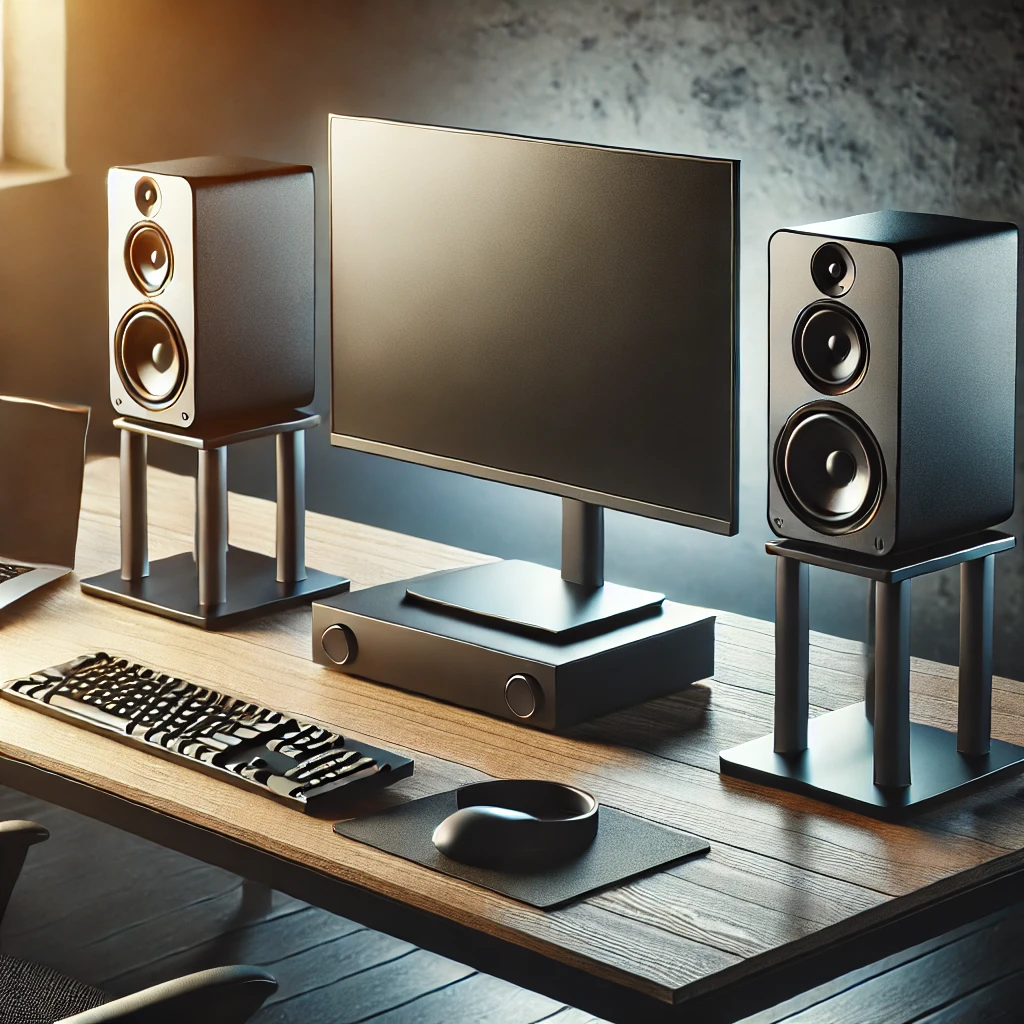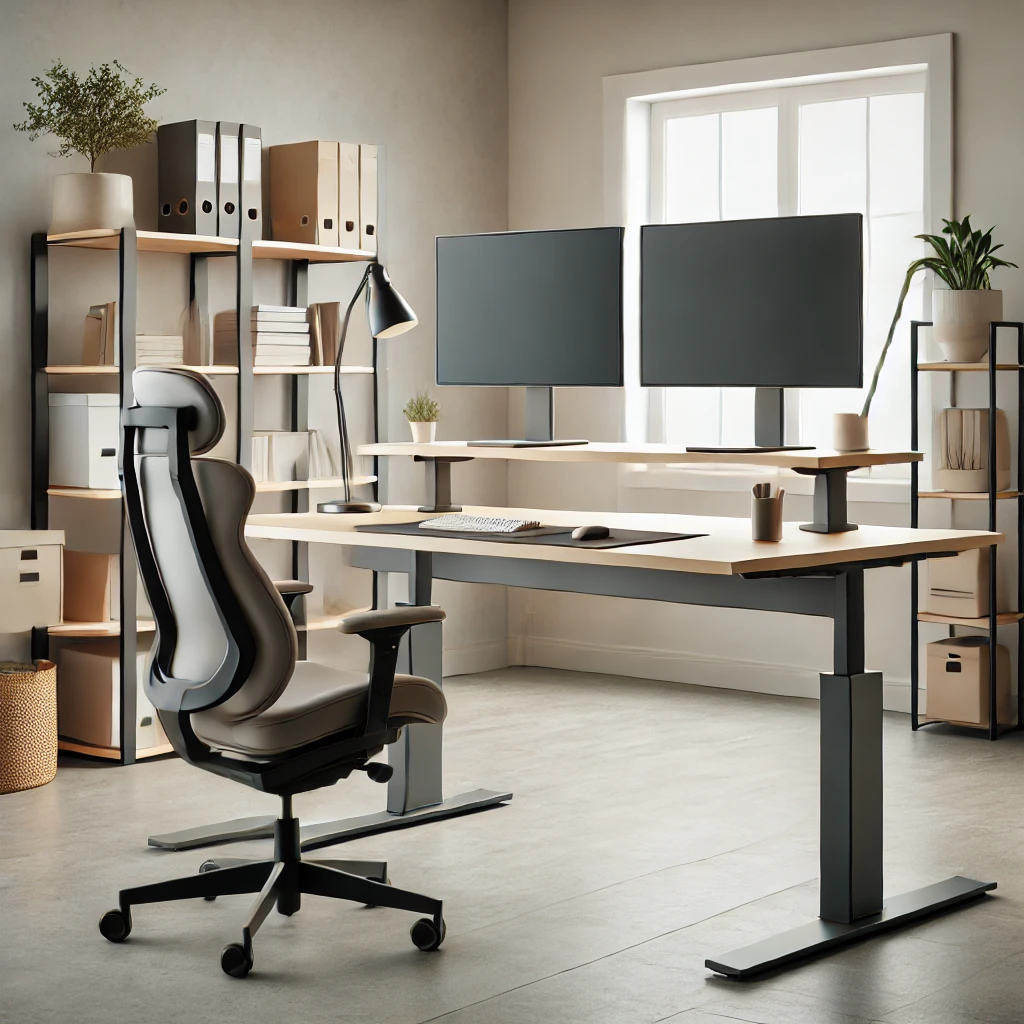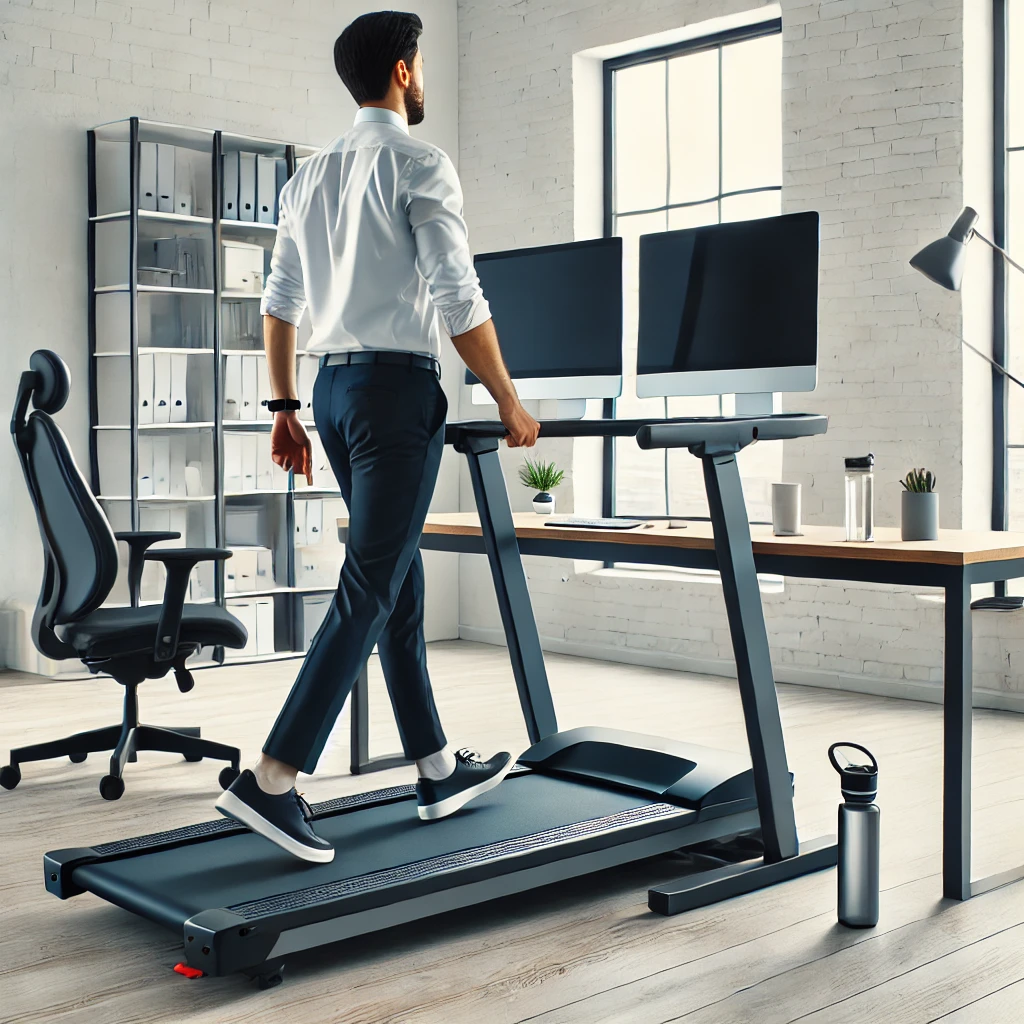Why Your Speakers Deserve Better Positioning
Have you ever felt that your desk speakers aren’t delivering the crisp, immersive sound experience you expected? I certainly have. After spending hundreds of dollars on quality speakers, I was disappointed until I discovered a game-changing solution: desk speaker stands. ✨
As an audio enthusiast who has tested countless setups, I can confidently say that proper speaker positioning is just as important as the quality of the speakers themselves. Desk speaker stands aren’t just accessories—they’re essential tools that can drastically transform your listening experience.
In this comprehensive guide, we’ll explore everything you need to know about desk speaker stands—from understanding why they matter to selecting the perfect pair for your setup. Whether you’re a music producer, gamer, or someone who simply enjoys high-quality audio, this guide will help you make an informed decision to elevate both your speakers and your listening experience.
Why Desk Speaker Stands Matter: The Science Behind Better Sound 🔊
Before diving into specific products, let’s understand why desk speaker stands are so crucial for optimal audio performance.
The Physics of Sound Positioning
When speakers sit directly on your desk, several acoustic problems occur:
✅ Sound Reflection: Desktop surfaces reflect sound, creating interference patterns that muddy the audio quality.
✅ Vibration Transfer: Speakers vibrate when producing sound. When placed directly on a desk, these vibrations transfer to the surface, causing distortion and resonance issues.
✅ Incorrect Listening Angle: Most desk setups place speakers below ear level, which isn’t ideal for accurate sound reproduction.
I learned this the hard way when I first set up my home office studio. My expensive monitors sounded mediocre until I elevated them to ear level using proper stands. The difference was like cleaning a foggy window—suddenly everything became clear and detailed.
The Acoustic Benefits of Using Stands
Desk speaker stands provide multiple acoustic advantages:
✅ Optimal Height Positioning: Proper stands position tweeters at ear level, where high frequencies are best perceived.
✅ Reduced Vibration: Quality stands include isolation features that minimize vibration transfer to your desk.
✅ Improved Stereo Imaging: With correct positioning, you’ll experience better stereo separation and a wider, more accurate soundstage.
✅ Decreased Desktop Reflections: Elevating speakers reduces early reflections from your desk surface.
According to a study by the Acoustic Society of America, correctly positioned speakers can improve perceived audio quality by up to 30%—regardless of the speaker quality itself. That’s a significant enhancement without upgrading your actual speakers!
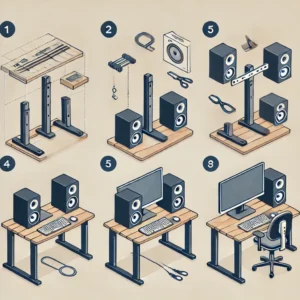
Finding the Perfect Height: The Golden Rule for Desk Speaker Stands 📏
One question I frequently receive is: “How tall should my desk speaker stands be?”
The answer follows what audio engineers call the “equilateral triangle” rule:
- Your head and two speakers should form an equilateral triangle
- Tweeters should be at ear level
- Speakers should point directly at your ears (with slight toe-in for some setups)
For most desk setups, this means stands between 4-8 inches tall, depending on:
- Your sitting height
- Desk height
- The size of your speakers
Remember that the goal is to have the tweeters (the smaller drivers that handle high frequencies) at ear level when you’re in your normal listening position.
7 Best Desk Speaker Stands That Will Transform Your Audio Experience in 2025
After extensive testing and research, I’ve compiled a list of the seven best desk speaker stands available today. Each offers unique benefits depending on your specific needs and setup.
1. Kanto S2 Desktop Speaker Stands
⭐ Key Features:
- 3 inches of height adjustment
- Built-in cable management
- Non-slip silicone pads
- Solid steel construction
- Angled design for optimal sound direction
💰 Price Range: $70-90
✅ Perfect For: Small to medium-sized bookshelf speakers
I’ve personally used these stands for over a year with my 5-inch studio monitors. The solid construction eliminates vibration, while the adjustable height allowed me to position my tweeters perfectly at ear level. The cable management is a thoughtful addition that keeps my desk looking clean and professional.
2. IsoAcoustics ISO-155 Studio Monitor Isolation Stands
⭐ Key Features:
- Patented isolation technology
- 14 height adjustment combinations
- Tilt adjustment capability
- Supports speakers up to 30 lbs
- Professional studio-grade quality
💰 Price Range: $110-130
✅ Perfect For: Professional audio production and serious audiophiles
These stands revolutionized my home studio setup. The isolation technology makes a remarkable difference—bass is tighter, mids are clearer, and the overall sound separation improved dramatically. While pricier than some options, the acoustic improvement justifies the investment for anyone serious about audio quality.
3. Gator Frameworks Desktop Clamp-On Studio Monitor Stands
⭐ Key Features:
- Clamp-on design saves desk space
- Adjustable height and angle
- Built-in cable management
- Supports speakers up to 20 lbs each
- Heavy-duty steel construction
💰 Price Range: $80-100
✅ Perfect For: Limited desk space and versatile positioning
When I downsized my workspace, these clamp-on stands were a lifesaver. They free up valuable desk space while still providing ideal speaker positioning. The adjustability is impressive—I can swivel, tilt, and adjust height with ease. Installation took less than 10 minutes, and they’ve remained rock-solid for months.
4. Audioengine DS1 Desktop Speaker Stands
⭐ Key Features:
- Sleek, minimalist design
- Silicone isolation pads
- 3° upward angle for ideal listening
- Solid steel construction
- Compact footprint
💰 Price Range: $30-40
✅ Perfect For: Smaller desktop speakers, particularly Audioengine models
These stands offer exceptional value. The silicone isolation effectively reduces vibration, and the slight upward angle naturally directs sound toward your ears. I recommend these for smaller setups where space is at a premium but sound quality remains a priority.
5. IsoAcoustics ISO-130 Desktop Speaker Isolation Stands
⭐ Key Features:
- Patented isolation technology
- Multiple height options
- Front-to-back tilt adjustment
- Suitable for speakers up to 20 lbs
- Professional-grade construction
💰 Price Range: $75-90
✅ Perfect For: Mid-sized monitors and bookshelf speakers
The ISO-130 stands deliver the acclaimed IsoAcoustics isolation technology at a more accessible price point. When I upgraded from basic foam pads to these stands, the improvement in clarity and stereo imaging was immediately noticeable. The ability to adjust tilt helps optimize sound for different listening positions.
6. MAYOVON Adjustable Desktop Speaker Stands
⭐ Key Features:
- Height adjustable from 4″ to 8″
- 360° swivel base
- Anti-slip silicone pads
- Supports up to 22 lbs per stand
- Modern aesthetic design
💰 Price Range: $40-60
✅ Perfect For: Versatile home setups and frequent repositioning
I recommend these to friends who need flexibility in their setup. The height adjustment range is generous, and the swivel base makes repositioning effortless. While not as acoustically sophisticated as isolation-focused stands, they provide excellent value for everyday users who want improved sound positioning.
7. Soundrise Pro Desktop Speaker Stands
⭐ Key Features:
- Solid bamboo construction
- Acoustic dampening design
- Cable management channel
- Eco-friendly materials
- Elegant aesthetic
💰 Price Range: $120-140
✅ Perfect For: Design-conscious users with wood-themed setups
When I redecorated my home office with natural wood elements, these bamboo stands were the perfect complement. Beyond their striking appearance, they provide excellent acoustic performance. The natural properties of bamboo help dampen vibrations, and the solid construction eliminates resonance issues.

Comparison: Finding Your Perfect Desk Speaker Stand Match
| Model | Height | Adjustability | Material | Weight Capacity | Isolation Tech | Price Range |
|---|---|---|---|---|---|---|
| Kanto S2 | 3″ | ✅ Adjustable | Steel | 20 lbs | ✅ Silicone pads | $70-90 |
| IsoAcoustics ISO-155 | 6″ | ✅ 14 positions | Composite | 30 lbs | ✅ Patented isolation | $110-130 |
| Gator Frameworks | 3″-12″ | ✅ Fully adjustable | Steel | 20 lbs | ✅ Foam pads | $80-100 |
| Audioengine DS1 | 2″ | ❌ Fixed | Steel | 15 lbs | ✅ Silicone pads | $30-40 |
| IsoAcoustics ISO-130 | 5″ | ✅ Multiple options | Composite | 20 lbs | ✅ Patented isolation | $75-90 |
| MAYOVON | 4″-8″ | ✅ Adjustable | Aluminum | 22 lbs | ✅ Silicone pads | $40-60 |
| Soundrise Pro | 4″ | ❌ Fixed | Bamboo | 25 lbs | ✅ Natural dampening | $120-140 |
Ready to transform your listening experience? Click through any of the models above to check current pricing and read verified customer reviews on Amazon! ⚡
How to Choose the Perfect Desk Speaker Stands: 5 Essential Factors 🔍
Selecting the right desk speaker stands involves considering several key factors:
1. Speaker Size and Weight
Always check the weight limit of stands before purchasing. Most desktop speakers weigh between 5-20 pounds, but professional studio monitors can be significantly heavier.
I learned this lesson when my first pair of flimsy stands collapsed under the weight of my 8-inch monitors. Measure both the weight and the base dimensions of your speakers to ensure compatibility.
2. Available Desk Space
Consider your desk’s dimensions and layout:
- Standard stands require surface space
- Clamp-on models save desk space
- Wall-mounted options eliminate desk footprint entirely
My current setup uses clamp-on stands because I value having maximum workspace on my desk surface.
3. Adjustability Requirements
Different stands offer varying degrees of adjustability:
- Height adjustment for proper ear-level positioning
- Tilt control for directing sound toward your listening position
- Swivel capabilities for repositioning
As someone who frequently rearranges my workspace, I prioritize stands with multiple adjustment options.
4. Acoustic Isolation Features
Superior stands include isolation technologies that prevent vibration transfer:
- Neoprene or silicone pads
- Patented isolation systems
- Foam inserts
- Decoupling mechanisms
The difference between basic stands and those with quality isolation features is immediately audible—particularly in the clarity of bass frequencies and overall sound definition.
5. Aesthetic Considerations
While sound quality should be the primary concern, appearance matters too:
- Material choices (metal, wood, plastic)
- Color options to match your workspace
- Cable management features
- Overall design integration with your setup
I prefer stands that include cable management solutions to maintain a clean, professional-looking workspace.
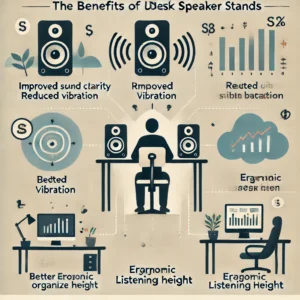
DIY Alternatives: Budget-Friendly Options for Speaker Elevation 🛠️
If commercial stands exceed your budget, several DIY approaches can provide similar benefits:
Foam Isolation Pads
Dense foam pads designed for speaker isolation can be effective for:
- Reducing vibration transfer
- Slightly elevating speakers
- Providing basic isolation
While not as effective as dedicated stands, they’re an affordable starting point at $15-30 per pair.
Repurposed Household Items
In a pinch, these household items can serve as temporary solutions:
- Hardcover books (wrapped in non-slip material)
- Wooden blocks or bricks (with padding)
- Adjustable desktop shelf risers
I started with stacked books before investing in proper stands—they worked surprisingly well as a temporary solution.
Custom-Built Wooden Stands
For the crafty audio enthusiast:
- Custom dimensions to perfectly fit your speakers and desk
- Material choices to match your decor
- Personalized height for your specific needs
- Built-in cable management solutions
A friend crafted beautiful walnut stands that cost less than commercial options while perfectly complementing his workspace aesthetic.
Installation and Positioning Tips: Maximizing Your Speaker Stand Benefits 🔧
Once you’ve selected your desk speaker stands, proper installation and positioning are crucial:
The 38% Rule for Optimal Room Placement
For overall room placement, audio engineers often recommend the “38% rule”:
- Place speakers approximately 38% of the way into your room from the wall behind them
- This positioning minimizes standing waves and room modes
I noticed significantly improved bass response after repositioning my desk according to this principle.
Dealing with Desktop Reflections
Even with stands, desktop reflections can affect sound quality:
- Consider placing a non-reflective mat on your desk between you and the speakers
- Position speakers so their acoustic centers form an equilateral triangle with your head
- Angle speakers slightly inward (toe-in) for improved stereo imaging
These small adjustments can significantly enhance clarity and imaging precision.
Cable Management Considerations
Proper cable management enhances both aesthetics and performance:
- Keep speaker cables away from power cords to prevent interference
- Use cable clips or channels to secure wires
- Ensure cables have sufficient slack to accommodate stand adjustments
Well-managed cables not only look better but also prevent accidental disconnections and potential tripping hazards.
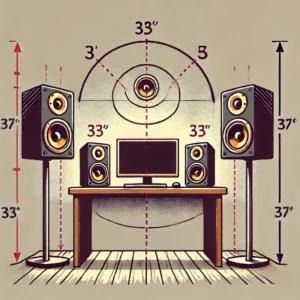
Common FAQs About Desk Speaker Stands 🤔
Are desk speaker stands worth it?
Absolutely. Proper speaker stands improve sound quality through optimal positioning and vibration isolation. The difference is immediately noticeable in clearer highs, more defined bass, and improved stereo imaging. Even budget speakers sound significantly better when properly positioned on quality stands.
What height should desk speaker stands be?
The ideal height positions your speakers’ tweeters at ear level when you’re seated at your desk. For most setups, this means stands between 4-8 inches tall, though adjustable options provide flexibility for different users and configurations.
Can I use speaker stands with any type of speakers?
Most desk speaker stands work with a wide range of speaker types, but always check weight capacity and base dimensions for compatibility. Some stands are designed specifically for certain speaker models or sizes.
Do speaker stands reduce vibration?
Quality speaker stands with isolation features significantly reduce vibration transfer between speakers and surfaces. This results in cleaner, more accurate sound reproduction, particularly in the low frequencies where vibration issues are most noticeable.
How do I prevent speakers from falling off stands?
Many stands include non-slip pads or surface treatments. For additional security, consider:
- Blu-Tack or similar removable adhesive
- Silicone non-slip pads
- Velcro strips for temporary mounting
- Speaker mounting screws (if compatible)
I use small silicone pads between my speakers and stands, which provide excellent grip without causing any damage.
Expert Tips for Advanced Users: Fine-Tuning Your Speaker Stand Setup 🧠
For audio enthusiasts seeking to extract every ounce of performance from their speaker stands:
Room Acoustic Considerations
Speaker stands are just one element of room acoustics. Consider:
- Adding acoustic panels to treat early reflections
- Using a rug or soft flooring to reduce floor reflections
- Implementing bass traps in corners to manage low frequencies
My home studio transformed after adding strategic acoustic treatments alongside proper speaker stands.
Experimentation with Toe-In Angle
The optimal toe-in angle varies based on speaker design and room characteristics:
- Start with speakers pointing directly at your listening position
- Gradually adjust inward or outward while playing familiar music
- Listen for changes in stereo imaging and soundstage width
- Select the position that provides the most natural, detailed presentation
I spent an entire weekend fine-tuning toe-in angles in my setup, and the improvement was well worth the effort.
Mass Loading for Improved Stability
Some stands benefit from additional mass:
- Fill hollow stand tubes with sand or acoustic damping material
- Add weight to the base for increased stability
- Use mass-loaded platforms between stands and speakers
This technique is particularly effective for taller stands or larger speakers, as the added mass further reduces unwanted resonances.
The Future of Desk Audio: Emerging Trends in Speaker Positioning ⚡
The audio industry continues to evolve, with several emerging trends in speaker positioning technology:
Intelligent Automated Positioning
Emerging technologies include:
- Smart stands that automatically adjust to optimal listening positions
- App-controlled height and angle adjustments
- Room calibration integration for perfect positioning
While still emerging, these technologies promise to simplify the process of achieving ideal speaker placement.
Integrated Desk Solutions
Furniture manufacturers are beginning to incorporate speaker positioning into desk designs:
- Built-in isolation platforms
- Adjustable speaker shelves
- Cable management systems designed specifically for audio setups
These integrated solutions offer elegant alternatives to traditional speaker stands.
Advanced Materials Research
Material science continues to improve isolation properties:
- Graphene-enhanced isolation pads
- 3D-printed structures with optimized resonance control
- Composite materials designed specifically for audio applications
These innovations offer promising improvements in vibration control and sound quality.
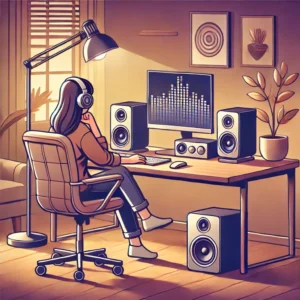
Conclusion: Elevate Your Audio Experience with Desk Speaker Stands
Proper speaker positioning is one of the most overlooked aspects of audio quality, yet it’s among the most impactful and cost-effective improvements you can make. Desk speaker stands transform not just how your speakers look on your desk, but fundamentally how they sound.
From my personal experience testing dozens of setups, I can confidently say that quality desk speaker stands provide:
- Dramatically improved clarity and detail
- Enhanced stereo imaging and soundstage
- Reduced desktop vibrations and resonances
- More accurate bass response
- A more professional, organized workspace
Whether you choose high-end isolation stands like the IsoAcoustics ISO-155, space-saving clamp models like the Gator Frameworks, or budget-friendly options like the Audioengine DS1, the improvement will be immediately apparent.
Ready to transform your listening experience? Click through any of our recommended models to check current pricing and read verified customer reviews on Amazon! 🔊
More FQAs:
❓ How do desk speaker stands enhance audio quality?
✅ Desk speaker stands elevate speakers to ear level, reducing sound reflections from the desk surface and minimizing vibration transfer, resulting in clearer and more accurate audio...
❓ What features should I look for when choosing desk speaker stands?
✅ Key features include adjustable height to align speakers with ear level, sturdy construction to support speaker weight, and isolation pads to reduce vibrations and prevent sound distortion...
❓ Can desk speaker stands improve stereo imaging?
✅ Yes, by positioning speakers correctly, stands enhance stereo separation and create a wider, more precise soundstage, improving the overall listening experience...
❓ Are there specific materials recommended for desk speaker stands?
✅ Materials like solid steel or high-quality wood are preferred for their durability and ability to dampen vibrations, contributing to better sound quality...
❓ How do I determine the ideal height for my desk speaker stands?
✅ The ideal height positions the speakers' tweeters at your ear level when seated, ensuring optimal high-frequency sound perception and a balanced audio experience...
Recommended for You:
- AMQ Standing Desk: 7 Incredible Benefits for Your Ultimate Workspace Upgrade
- Stand Up Desk Store: The Perfect Solution for a Healthier Workspace in 2025
- Best Solid Wood Standing Desks 2025: Elevate Your Office with Natural Elegance
Disclaimer: This article contains affiliate links. If you purchase products through these links, we may earn a small commission at no additional cost to you.

